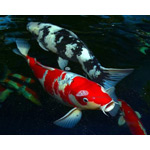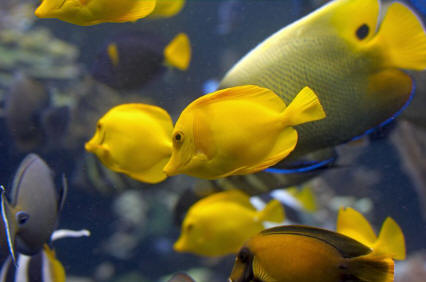Japanese Koi (assorted grade)

|
Scientific Name: Cyprinus carpio Price: Upon Request Origin: Asia Family: Cyprinidae NOT AVAILABLE NOW |
|
Other Names: Koi carp, Cyprinus carpio carpio, Common carp, European carp |
|
Technical Info
Temperature: 17 - 22 ℃
pH: 7.4 - 7.9
GH: 10 - 14
Max size: 60 cm
Min Tank size: 500 Ltr
Position in Aqua: No special swimming level
Description
Carp often grow 30 to 60 cm in length and weigh 0.5 to 4 kg (Tomelleri and Eberle 1990); it is not uncommon for common carp to reach 15 to 20 kg (McCrimmon 1968). Males are usually distinguished from females by the larger ventral fin. Carp are characterized by their deep body and serrated dorsal spine (Nelson 1984). The mouth is terminal on the adult and subterminal on the young (Page and Burr 1991). Color and proportions are extremely variable, but scales are always large and thick. Three sub-species with slightly different scale patterns are recognized.
Food
Carp are omnivorous. The common carp can eat a vegetarian diet of water plants, but prefers to scavenge the bottom for insects, crustaceans (including zooplankton), benthic worms, or the occasional corn snack from tourists
Breeding
An egg-layer, a typical adult fish can lay 300,000 eggs in a single spawning. Although carp typically spawn in the Spring, in response to rising water temperatures and rain fall, carp can spawn multiple times in a season. In commercial operations spawning is often stimulated by injection. Carp lay eggs by the hundreds of thousands, yet their population remains the same, so the eggs and young must perish in similar vast numbers. Eggs and fry often fall victim to bacteria, fungi, and the vast array of tiny predators in the pond environment. Those fortunate enough to survive to juvenile are preyed upon by other fish such as the northern pike and largemouth bass.
Compatible with
Best kept with other Koi, maybe the common plecostomus.

